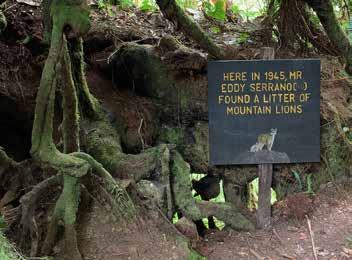
11 minute read
Destinos
El Residente 6 Destinos
by William Duckwall
Advertisement
Quetzal Quest
Daniel Oduber Quirós, whose name you may recognize if you have flown into the country via the airport bearing his name in Liberia, was president of Costa Rica from 1974 through 1978. During his presidency the national bird was chosen – the yigüirro, or clay-colored thrush, formerly, and still sometimes, called the clay-colored robin. This bird bears the unflattering scientific name Turdus grayi (but, it is in good company – the American robin, with the red breast, is Turdus migratorius). Interestingly, the two birds play similar parts in the two cultures. We Norte Americanos associate the appearance and song of robins with the advent of spring; in Costa Rica the melodious song of the clay-colored thrush marks the welcome return of the rains. The Oduber administration was focused on social and working-class issues – securing better pricing for agricultural products, preserving natural resources, and fostering good relations across Central America. It is consistent that the Oduber administration, with its focus on the working class, would pick the plainest workingclass bird in the country as the national bird. In its way, however, this bird symbolizes important parts of Costa Rica’s character; it is modest and unpretentious and it likes people, often nesting near homes. It can be found nearly everywhere in the country. Its one standout feature is its enchanting song. The digression about Daniel Oduber and Turdus grayi springs from my own idle curiosity – was there no controversy in 1977 when it was selected? Surely there were those who advocated birds with a bit more pizzazz? There are dozens of possibilities – the scarlet macaw, the keel-billed toucan, the harpy eagle, maybe one of the motmots or hummingbirds. Notice I didn’t mention the quetzal, one of the most striking birds in the world, as it has been the national bird of Guatemala since 1871, and is featured on their currency, which is even denominated in – quetzals. So perhaps the quetzal was viewed as already spoken for.

To see a clay-colored thrush: From nearly anywhere in the country with a bit of greenery, walk outside and listen for birdsong that reminds you of the song of an American robin. If you see a bird that is about the same size and shape as a robin, but colored a nearly uniform light-to-medium brown, that’s it. National bird or not, bird watchers are not stampeding to Costa Rica to see clay-colored thrushes. To see a quetzal, well that’s a bit more involved. The Costa Rican quetzal is the resplendent quetzal, Pharomachrus mocinno (costaricensis), closely related to the slightly larger Guatemalan quetzal. Whether you pronounce it in the English fashion (ket saal) or in a Spanish fashion, with more emphasis on the ket and quick curt voicing of the second syllable, sal, everyone will know what bird you mean. The name came from Nahuatl, the original language of the Aztecs in central Mexico, into Spanish, and then to English. The bird is spectacularly colored, iridescent green, or brown – depending. It turns out that their coloration is caused by microscopic stripes of brown pigment alternating with translucent stripes, with such regular spacing that the feathers absorb most colors of light but strongly reflect green. (When you see rainbow colors reflecting from a CD it is this same sort of interference effect; there are no colored pigments in the CD. Blue morpho butterflies use the same trick to appear blue.) In direct sunlight the bird is iridescent green. In shadow it is far less conspicuous. The chest is red, and, in males, a pair of long (24 inches or more) green tail feathers flow behind. (There are actually four elongated tail feathers, two that are 10-inches or so, and two that are extremely long.) The quetzal belongs to the trogon family; it is the largest of the ten trogons in the country. They favor higher altitudes, like the cloud forests. For birders, the quetzal is high on the list of must-sees. The quetzal is not on the endangered list, but it is not common. It nests in cavities in dead trees, often enlarging abandoned woodpecker nests. Nesting quetzals are only to be found in mature forests with a


supply of standing dead, partially rotted wood. This is one of the major constraints on their distribution and on their reproductive rate; wood that is sufficiently decayed to be workable for a quetzal is not likely to stay intact for long in the wet windy climate, and nest failures are common. They feed on fruits, insects, and reportedly, frogs and lizards. A favorite fruit is the wild avocado, known locally as the aguacatillo. Before you go looking for chips, I should mention that these avocados are about the size of olives and consist mostly of skin and seed. Forget about guacamole. However, your best bet for finding quetzals is to be near a fruiting aguacatillo. The bird eats the fruit whole and regurgitates the seed a half-hour later. Experienced guides sometimes hear the plonk of the falling seed and look up to find the quetzal perched above. (I read this somewhere. There’s a lot of plonking in the cloud forest, so I’m not really convinced that this is your best strategy.) There are three or four areas in the country known for quetzals, though truthfully anywhere that offers cloud


forest would likely harbor them. Many tourists have seen quetzals in the Monteverde cloud forest – we saw our first quetzal there many years ago while on vacation. It is a preferred ecotour destination with a great variety of birds and distinct ecology, however it is a torturous two-hour drive from San José, so perhaps best if you have a few days to spend in the area. One spot closer to San José is the Barva sector of Braulio Carrillo National Park. The park is 1.5 hours away from San José, north of Heredia, and a true gem. Access is a little difficult; four-wheel drive is advised. It doesn’t draw a lot of foreign tourists, but there are good trails to follow for day hikes. Perhaps there is a preferred season for finding quetzals. I’ve been there once or twice, but saw no quetzals. Last February our son was scheduled for a visit. We wanted to take him somewhere with guaranteed quetzals, so we took the advice of some Tico friends and went to the area near Los Quetzales National Park. It is a two-hour drive from San José over good roads – just follow Ruta 2 through Cartago and keep going for another hour. We stayed at a


hotel on the San José side of the park, a spot with its own forest reserve. This hotel, Mirador de Quetzales (shown as “Albergue Mirador de Quetzales” on Google Maps) is a ten-minute drive from the park itself and is widely known among birders. It is a beautiful spot with a friendly helpful staff. Janet and I had stayed there in June the year before, but saw none. We were assured that if we returned in January or February we were 100% certain to see quetzals. This trip we saw so many we lost count. The Mirador de Quetzales property was first claimed by Eddi Serrano and his wife Leonor in the 1950s. Eddi was a day laborer from Cartago who dreamed of having his own land. Back then there was only a dirt road into the area, but the highlands were beautiful, and all that was required to own land there at that time was to fence it off and move in. Those early years were difficult, and Eddi had to take day jobs in the area to feed his family. Eddi cleared a hillside on his property so that he could raise blackberries. For a time he generated income by selling first, wood and charcoal, and then berries. By 1990 the hard times were largely over, but by then he had several of his children – now grown and married – living on the property, and there was really no way to scale up the berry business. With the help of a neighbor who spoke English, he fashioned a sign – WELCOME TO THE QUETZAL FARM. He posted the sign beside the highway one morning, and two hours later a couple pulled up to his house; they wanted to see the quetzals! That was the humble beginning of his ecotourism business – no guides, no binoculars or telescopes, all in Spanish – but it changed everything for Eddi and for everyone living in the highland area. Now, thirty years later, you must

reserve your rooms far in advance, especially during the peak viewing season of December through March. The property is at an elevation of 8,500 feet. I was surprised to see the elevation sign in the parking area; I knew that the road had been steadily climbing since leaving Cartago, but the climb is so gradual that you don’t realize how far up you’ve come. Incidentally, it is cool at this elevation, and cold at night. The rooms aren’t heated, but like many mountain hotels they will send you off for the night with a felt-covered hot water bottle from the kitchen. And, there are enough blankets for a long hibernation. Rain is always possible, likely even, and rainwear is advisable. If you are reading a Google-translated webpage you may be momentarily puzzled at the recommendation to bring a cape. This is a misleading translation – the message is really to bring your rain poncho. Please put out of your mind
El Residente 10
any apprehension you may have had about vampires or English schoolmasters. I think everyone you meet working at the hotel is a member of the Serrano family. They are a hard-working bunch; the waiter for your evening meal is likely to be your guide for your morning bird walk. You’re in good hands with all of them. The restaurant is very good by the way – a varied menu – we tried the homemade ravioli, and a couple of variations of fresh trout. And there is a cozy wood-burning stove near the kitchen, where your group can gather before dinner for a drink. There is a two-hour long trail on the property that you are welcome to walk on your own whenever you want. This trail winds back and forth and up and down a heavily forested hillside. We spotted a pair of quetzals there when we visited with our son on the afternoon we arrived; we saw another six or so the next morning with a guide, all in the same general area. There are of course other birds to be seen; a row of hummingbird feeders sits in front of the restaurant, generating a constant buzz of activity of the tiny bejeweled birds. For variety, you can always drive another ten minutes to the Parque Nacional de Quetzales where there are dirt roads and hiking trails to be explored. There is another area nearby also known for quetzals – San Gerardo de Dota – which is highly recommended by many writers. I have not visited it myself, but since there are only a handful of rooms available at Mirador de Quetzales, I feel I should give some alternatives. About four kilometers past the Parque de Quetzales, there is a side road on the right – Calle San Gerardo – which drops down to San Gerardo de Dota, passing a series of inviting spots like Miriam’s Quetzals, Dantica Cloud Forest Lodge, the Trogon Lodge, and more. Past town there is the larger Savegre Hotel and Spa and the small Suria Lodge, which is nearly at the end of the road, close to the Savegre River. Interestingly, some writers suggest March and April as the peak times for quetzals in this area, which would be a little later than the peak season at Mirador de Quetzales. This area is also known for trout fishing – rainbow trout now thrive in the cold mountain waters. Let’s hope that in the near future we will all be able to travel freely again, to see and experience the varied terrain and cultures of this beautiful country, a country squeezed between the Caribbean and the Pacific, bridging the Americas. (Otherwise, my next article will be about the big tree in my yard.) Until then, stay well everyone.

William is a retired engineer who lives in Guapiles with his wife Janet. He has varied interests – Costa Rican birds and orchids – and writes a little now and then. He can be reached at: bduckwall@mac.com
To ship from HERE
to HERE


Partial or Full containers directly door to door from Canada and USA to Costa Rica. We pickup palletized shipments all over the USA Cars - Boats - Motorcycles - Quads - ATV's - Equipment - Lumber - Prefab Homes. Moving back to the USA? We do that too! We are logistics consultants. Toll free: 1-866-245-6923 • Phone: (506) 2431-1234 • Fax: (506) 2258-7123










